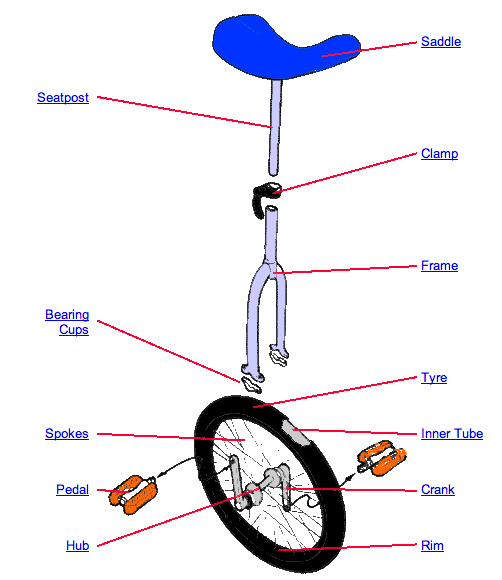Welcome to the wonderful world of Unicycling and Physics!
This site goes over the basics
of the unicycle and some of the physics behind it. Under the link
"Basics of Unicycling" are fun videos that explore some of the aspects
of unicycling as well as brief descriptions of Riding, Turning and
Idling on a unicycle. Under the "Stability of a Unicycle" link is a
look into how it is physically possible for humans to ride the unicycle.
An explanation of what a unicycle is and a brief history behind it
are found below as well as a little about me!

George Peck unicycling on
the beaches of Seward, AK with Mt. Marathon in the background.
What is a Unicycle?
A Unicycle is a one wheeled cycle made up of, very simply:
one wheel, a seat, two pedals, two cranks, and a fork. It
has no brakes, no handlebars, and no training wheels. A detailed
diagram is included below. The diagram shows a basic unicycle, however,
unicycles can come in many shapes and sizes. Tall unicycles i.e. 6ft
tall, are called giraffes. Unicycles can have smaller tires i.e. 1ft,
bigger tires i.e. 3ft, fat tires for off roading and thinner tires for
street riding. Some unicycles even come without the seat! Those without
a seat are called Ultimate Wheels and are another story in themselves.
The Unicycle is fun for all ages and is a good, fun, form of excersise.
It is very small and light weight, so you can take it many places and
more that a bike can go! You don't have to go very far to get a good
work out and you can have fun with Physics too!

http://www.unicycle.uk.com/FAQ.asp?iCategory=75&cat=Parts+of+the+unicycle&FAQParentID=75
*Please note that the purple seated unicycle animation above also came from this site
History of the Unicycle
Although a little unclear, the Unicycle is
believed to have come from the Penny
Farthing. A Penny Farthing had a very large wheel in front with the
pedals and cranks connected directly to the hub, much like the
unicycle, and it had a very small tire in the back, probably for
balance. Basically, the Penny Farthing was an oversized unicycle with a
training wheel and handlebars. The unicycle was born when riders took
off the back wheel and just rode the big wheel. Yet another interesting
fact about the unicycle is that it predates the bicycle, although some
may argue that the Penny Farthing was a bicycle because it had two
wheels. Today, unicycles are smaller and come in many diameters and
seat post length and tire grip, usually they're specified to their use.
For example: for doing tricks you would want your unicycle to be very
sturdy, have a fat tire and be a smaller than average (an average wheel
is about 28 inches). As illustrated above in the diagram, there are
many components to a
unicycle. The sturdier the components, the heavier the unicycle.
Anything and everything can be beefed up or made slimmer on a unicycle
and has. If you were touring with your unicycle you would want lighter
components and a bigger wheel for riding across those long distances.
In the above picture, George Peck is demonstrating MUNI (Mountain
UNIcycling) or Rough Terrain Unicycling. As the founder of the sport,
Peck started out with an average unicycle but has gradually improved it
and now most people use an average or a little larger than average size
tire, sturdy components and sometimes a handbrake. Handbrakes on
unicycles are fairly new and are often placed just below the seat for
ease of use. Brakes are useful for when balancing on rocks and roots
and basically anytime you want minimal slippage like when you have a
very small landing area.
